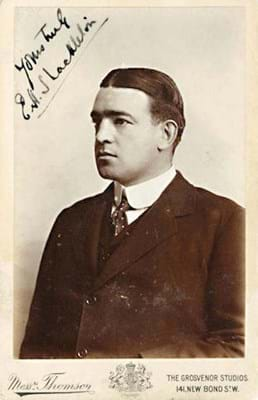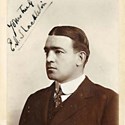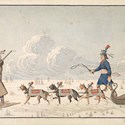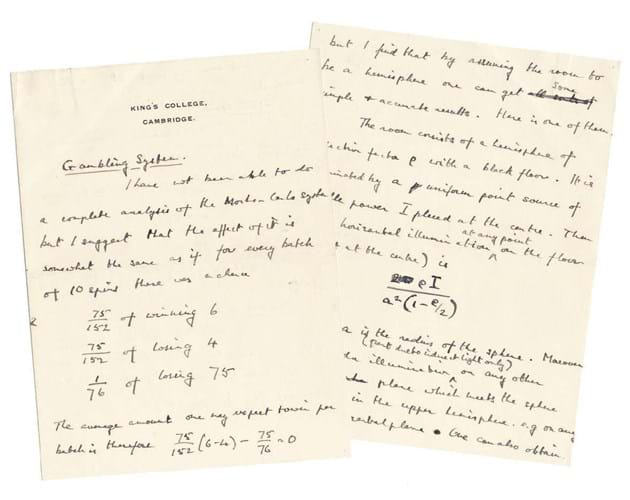
Letters in the hand of Sun Yat-Sen and Alan Turing were among the top lots at Bonhams (27.5/25/20/14.5% buyer’s premium) on September 15.
Anything relating to Turing has been making strong prices in recent times. In this Knightsbridge sale a previously unpublished letter of 1933 in which Turing attempts to analyse a ‘Monte Carlo’ gambling system doubled the high estimate to sell at £75,000.
As a young man Alfred William Beuttell had made a fortune from patenting the Linolite electric strip reflector lamp – more commonly known as strip lighting – and this, said Bonhams, enabled him to focus his energies on flying, motor racing and sailing by day, while spending his evenings and money in casinos.
It was in 1932, when his gambling days were long past, that Beuttell gave a copy of his ‘Monte Carlo’ betting system to Turing, a good friend of his son who was spending that Christmas with the Beuttells. He asked their guest for his views.
Turing was typically thorough in his analysis of that system, though Bonhams felt that there was a certain “tongue in cheek” element in his application of mathematics and equations to what he regarded as an essentially light-hearted subject.
Turing concluded that the more one played, the probability of losing increased, noting “...for short runs one most probably wins or else one loses loses an unexpectedly large sum. As the length of the run is increased the chances of winning become more remote & and negligible for 100,000 spins.” In other words, more luck than judgement was involved.
Matthew Haley of Bonhams said of the letter, “...it shows a side to Turing not often portrayed in the media today – amusing, supportive and self-deprecating – yet also ephasises his fascination with probability, and its application to cryptology ...the key to the work at Bletchley Park for which he is known and rightly regarded as a national hero”.
Rare at auction
Autograph letters from Sun Yat-Sen – a man who was influential in the overthrow of the Qing (Manchu) dynasty, served as the provisional president of the Republic of China 1911-12 and later, from 1923-25, as the country’s de facto ruler – rarely come to auction. Only four, three in English and one in Chinese, are listed in auction records of the last 20 years, said Bonhams.
Sold at £25,000 was a brief note on RMS Adriatic (White Star Line) notepaper. Addressed to his old friends, Doctor and Mrs Cantlie, it is dated November 8, 1911, and announces that he is on his way to London as soon as he has “settled up business” and requests them to “Please keep my movement strictly secret, for it is very important to our cause”.
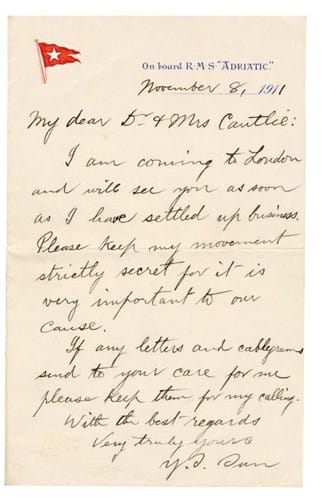
Sold for £25,000 at Bonhams was a brief note on RMS Adriatic (White Star Line) notepaper in the hand of Sun Yat-Sen.
He also asks that any post for him he kept and only handed over to him in person.
Much earlier letters in the Knightsbridge sale, bearing the signatures of Henry VIII and Elizabeth I, sold at £18,000 and £15,000 respectively.
Among the modern firsts, a set of Tolkien’s Lord of the Rings trilogy, first-impression copies of 1954 and complete with dust jackets, made £30,000.
Travel focus
In the previous day’s sale at Bonhams, where the focus was on travel and exploration, a bid of £42,000 was taken on an album of 65 works on paper documenting an 1857-61 naval expedition from England to south-east Asia aboard HMS Chesapeake. This was the work of Lt Col William Godfrey Rayson Masters of the Royal Marines.
A couple of lots focusing on Ernest Shackleton proved much more expensive than had been anticipated.
A brief letter addressed at Christmas 1919 to the artist Charles Buchel, apologising for not having come to see him for a final sitting for the portrait on which he had been working – presumably that which now hangs in the National Gallery of Ireland, said Bonhams – was sold for £18,000 rather than the suggested £600-800.
A cabinet photo-portrait of Shackleton, signed in the image and dating from around 1903, was bid to £7000.
This sale’s top lot, at £90,000, was a watercolour and bodycolour work by Peter Rindisbacher, probably dating from the early to mid 1820s.
Depicted are an Indian guide, wearing snowshoes, a very orderly and handsomely attired dog team, and a smartly dressed, whip-wielding figure who would appear to be the master of the dog team. Seated, almost lying in what was known as a ‘dog cariole’, is the unknown gentleman whose icy expedition is being depicted.
Aged just 15, but already a professionally trained painter and printmaker, Rindisbacher had emigrated from Switzerland ito North America with his family in 1821, eventually finding a home on Lord Selkirk’s Red River Settlement at Winnipeg. In 1826, however, the family moved to the US and Rindisbacher eventually settled in St Louis.
He died in 1834, aged just 28, but by then his pictures of native life and culture had brought him considerable success. Wider distribution of his work was ensured by the production of printed versions, and such was the esteem in which this particular work was held that it was selected as one of six of his works that the Hudson’s Bay Company had published in London in 1825.


